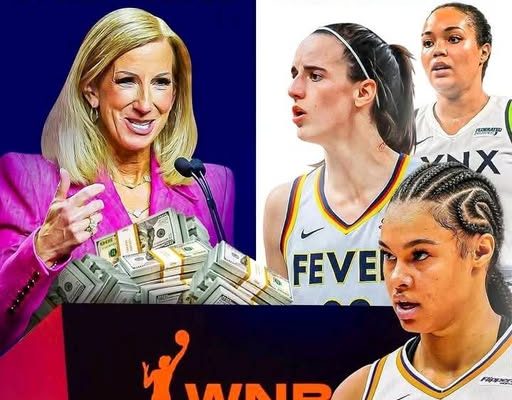The story of the WNBA players turning down a deal that would have instantly quadrupled their salaries has shocked many sports fans and casual observers alike, and yet, when looked at through the lens of fairness, history, and economic structure, it begins to make much more sense. According to ESPN’s report, the proposal on the table would have boosted the league’s minimum salary from $66,000 to $250,000 and taken the maximum from $250,000 to $1 million. On the surface, this is a staggering leap forward, one that almost any other worker in any other industry would accept immediately, as the difference between struggling to make a living wage and earning six or seven figures is monumental. But the WNBA players have made a bold, calculated decision: they have rejected the deal because they want more than just salary bumps, they want a share of the revenue, a seat at the same economic table where NBA, NFL, and MLB players already dine. This is not about being ungrateful, it is about demanding structural change in how they are valued by their league.
To many, the optics are jarring. A league still fighting for mainstream visibility and attendance has players saying no to the kind of money most people will never see in their lifetimes. But this is the crucial part that cannot be ignored: the WNBA players are not merely employees asking for raises, they are partners in generating value for the league, and the very fact that ownership was willing to offer such a large jump in compensation signals that there is far more money available in the system than what the athletes have historically received. That becomes especially evident when comparing the WNBA to the NBA, which operates under a collective bargaining agreement where the players receive roughly 50% of all basketball-related income. Similarly, NFL and MLB players hover between 48 and 50% of league revenues. The WNBA players currently get just 9.3%. In other words, the deal the WNBA players turned down, while looking massive compared to their current checks, still would not put them anywhere close to the model of equitable distribution that is standard in other professional sports. That is why this refusal is not reckless—it is strategic.
The timing of this battle is everything. The WNBA is entering a critical new phase of growth, one that will be fueled by a $2.2 billion, 11-year television deal starting next season. To put that into perspective, that is a financial commitment that dwarfs anything the league has seen before, and it has raised franchise values across the board. Expansion fees, sponsorships, attendance records, and media exposure are all trending upward, creating the sense that the WNBA is not only sustainable but potentially on the verge of exponential growth. If players accept a deal now that locks them into fixed salary increases without tying compensation to revenue, they run the risk of missing out on the real windfall. And in professional sports, as in business, timing is often the difference between generational wealth and generational frustration.
Turning down such an offer is undoubtedly a gamble. Striking for more means risking seasons lost, public opinion turning against the players, and careers being shortened by missed years of play. Unlike NBA players, many of whom make tens of millions annually and can withstand lockouts, WNBA players have historically had to supplement their incomes by playing overseas during the offseason. The paychecks, while higher than before, are still modest by pro-athlete standards, and very few can simply sit out a year without consequences. This is why the move is being seen as both bold and dangerous—it places tremendous faith in the league’s continued upward trajectory and in the players’ ability to win the narrative battle against ownership.
But history shows that the biggest changes in labor relations rarely come without bold acts of defiance. The NBA players’ current financial model exists because previous generations struck and negotiated hard. The NFL has gone through repeated lockouts to protect and expand its share of revenues. Major League Baseball players endured strikes that cost them entire seasons in the pursuit of fairer collective bargaining agreements. The difference here is that the WNBA players are starting from a much lower baseline, and they are demanding a shift not just in salary scales but in philosophy. They want to be recognized not as employees given allowances but as partners in the business. Their argument is simple: if they are producing the product, drawing fans, attracting TV money, and raising the value of franchises, then they deserve a share of the bottom line. Anything less is inequity disguised as generosity.
The rejection of the deal also highlights a deep tension between optics and substance. The average sports fan, hearing that WNBA players are turning down $1 million max contracts, might scoff and argue that they should be grateful. But those same fans do not usually pause to consider how much money is flowing into the league compared to how little of it reaches the athletes. If the NBA model were applied to the WNBA’s $2.2 billion media deal, players would be in line to share nearly half of that. The fact that ownership is willing to concede a quadrupling of salaries but not revenue sharing tells you everything about where the money is really going. To accept such a deal would be to sell short their future for temporary relief.
There is also the broader cultural and gendered component of this fight. For decades, women’s sports have been underfunded, undervalued, and dismissed as niche. The WNBA’s struggle for fair pay is as much about changing perception as it is about changing bank balances. Accepting a bump to $1 million without revenue sharing would have been a symbolic victory but not a systemic one. Standing firm on revenue percentage sends a louder message: women athletes will no longer accept scraps from the table when they are cooking the meal. In that sense, this dispute is about more than the WNBA; it is about women’s labor across industries, where underpayment and undervaluation are constant themes.
The looming possibility of a strike now feels more real than ever. Labor disputes are always about brinkmanship, about who blinks first. Ownership is betting that the players cannot afford to miss paychecks, while the players are betting that the league cannot afford to alienate fans, TV partners, and sponsors right as it begins a new era of growth. Strikes are costly, divisive, and risky, but they also have a way of crystallizing what is at stake. If WNBA players do walk out, it would signal that they are willing to endure short-term pain for long-term justice, and it would place tremendous pressure on the league to negotiate in good faith.
At the heart of all of this is a simple question: how much is fairness worth? To the average worker, walking away from a 400% raise sounds absurd, but in the context of professional sports economics, it is a necessary stance. If they fold now, they may not get another chance for decades. The league is growing, the TV deals are locked in, and the franchise fees are climbing. The players are acutely aware that their value has never been higher, and they want to capitalize on that moment rather than let ownership dictate terms that could look increasingly outdated within a few short years.
What makes this such a compelling story is the intersection of risk and principle. These players are not only fighting for themselves but for future generations of WNBA athletes. By demanding revenue sharing, they are planting a flag for equality and sustainability, ensuring that as the pie grows, their portion grows with it. And if that means risking public backlash, enduring financial hardship, or facing the disruption of a strike, then so be it. The history of sports labor disputes is full of moments where players had to gamble big to win big.
In the end, whether the WNBA players’ gamble pays off will depend on whether fans, sponsors, and the media see their fight as justified. If the public narrative becomes one of “greedy players turning down $1 million salaries,” ownership will have the upper hand. But if the story is framed as “players demanding the same revenue-sharing model every other major league enjoys,” then the players may find themselves with widespread support. And that distinction may well determine whether the WNBA enters its next era as a league where players are finally treated like equal partners, or whether it remains one where they are paid more generously but still denied true equity.
The fact remains that when anyone turns down four times their current salary, it says something profound about what they believe they are worth and what they believe is possible. The WNBA players are signaling that they are no longer willing to accept incremental progress when the potential for real transformation is within reach. They have chosen the harder road, the riskier road, but perhaps the only road that leads to lasting fairness. And if history is any guide, those who demand equity rather than accept charity are the ones who eventually change the game forever.



